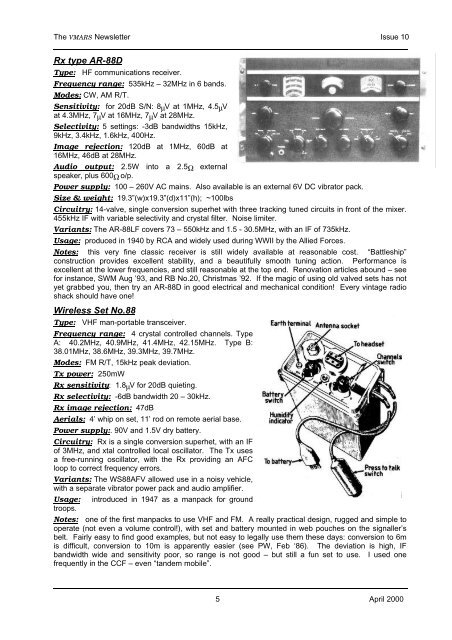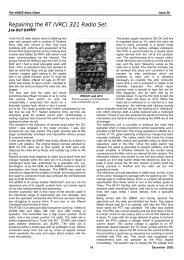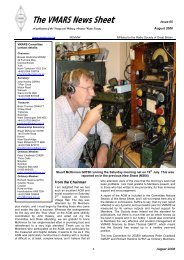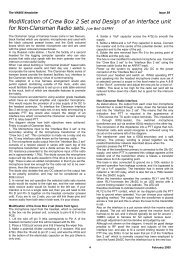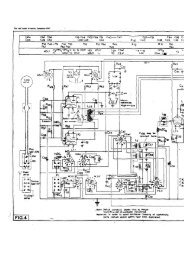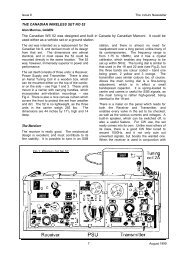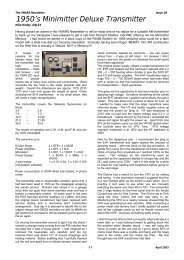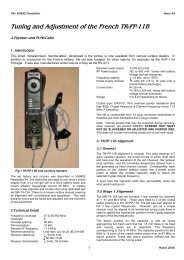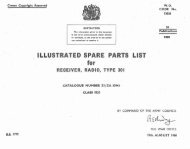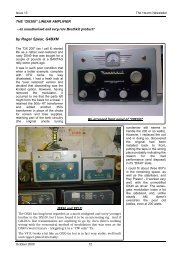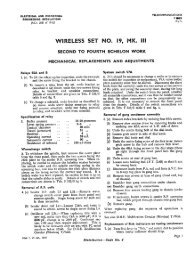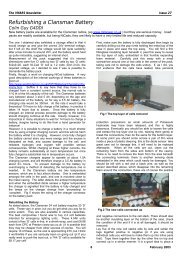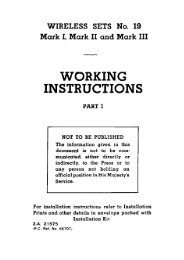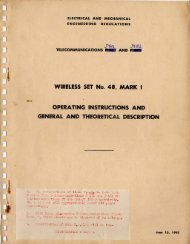The VMARS Equipment Directory – Part 1 - VMARSmanuals
The VMARS Equipment Directory – Part 1 - VMARSmanuals
The VMARS Equipment Directory – Part 1 - VMARSmanuals
You also want an ePaper? Increase the reach of your titles
YUMPU automatically turns print PDFs into web optimized ePapers that Google loves.
<strong>The</strong> <strong>VMARS</strong> Newsletter Issue 10<br />
Rx type AR-88D<br />
Type: HF communications receiver.<br />
Frequency range: 535kHz <strong>–</strong> 32MHz in 6 bands.<br />
Modes: CW, AM R/T.<br />
Sensitivity: for 20dB S/N: 8µV at 1MHz, 4.5µV<br />
at 4.3MHz, 7µV at 16MHz, 7µV at 28MHz.<br />
Selectivity: 5 settings: -3dB bandwidths 15kHz,<br />
9kHz, 3.4kHz, 1.6kHz, 400Hz.<br />
Image rejection: 120dB at 1MHz, 60dB at<br />
16MHz, 46dB at 28MHz.<br />
Audio output: 2.5W into a 2.5Ω external<br />
speaker, plus 600Ω o/p.<br />
Power supply: 100 <strong>–</strong> 260V AC mains. Also available is an external 6V DC vibrator pack.<br />
Size & weight: 19.3”(w)x19.3”(d)x11”(h); ~100lbs<br />
Circuitry: 14-valve, single conversion superhet with three tracking tuned circuits in front of the mixer.<br />
455kHz IF with variable selectivity and crystal filter. Noise limiter.<br />
Variants: <strong>The</strong> AR-88LF covers 73 <strong>–</strong> 550kHz and 1.5 - 30.5MHz, with an IF of 735kHz.<br />
Usage: produced in 1940 by RCA and widely used during WWII by the Allied Forces.<br />
Notes: this very fine classic receiver is still widely available at reasonable cost. “Battleship”<br />
construction provides excellent stability, and a beautifully smooth tuning action. Performance is<br />
excellent at the lower frequencies, and still reasonable at the top end. Renovation articles abound <strong>–</strong> see<br />
for instance, SWM Aug ’93, and RB No.20, Christmas ’92. If the magic of using old valved sets has not<br />
yet grabbed you, then try an AR-88D in good electrical and mechanical condition! Every vintage radio<br />
shack should have one!<br />
Wireless Set No.88<br />
Type: VHF man-portable transceiver.<br />
Frequency range: 4 crystal controlled channels. Type<br />
A: 40.2MHz, 40.9MHz, 41.4MHz, 42.15MHz. Type B:<br />
38.01MHz, 38.6MHz, 39.3MHz, 39.7MHz.<br />
Modes: FM R/T, 15kHz peak deviation.<br />
Tx power: 250mW<br />
Rx sensitivity: 1.8µV for 20dB quieting.<br />
Rx selectivity: -6dB bandwidth 20 <strong>–</strong> 30kHz.<br />
Rx image rejection: 47dB<br />
Aerials: 4’ whip on set, 11’ rod on remote aerial base.<br />
Power supply:. 90V and 1.5V dry battery.<br />
Circuitry: Rx is a single conversion superhet, with an IF<br />
of 3MHz, and xtal controlled local oscillator. <strong>The</strong> Tx uses<br />
a free-running oscillator, with the Rx providing an AFC<br />
loop to correct frequency errors.<br />
Variants: <strong>The</strong> WS88AFV allowed use in a noisy vehicle,<br />
with a separate vibrator power pack and audio amplifier.<br />
Usage:<br />
troops.<br />
introduced in 1947 as a manpack for ground<br />
Notes: one of the first manpacks to use VHF and FM. A really practical design, rugged and simple to<br />
operate (not even a volume control!), with set and battery mounted in web pouches on the signaller’s<br />
belt. Fairly easy to find good examples, but not easy to legally use them these days: conversion to 6m<br />
is difficult, conversion to 10m is apparently easier (see PW, Feb ‘86). <strong>The</strong> deviation is high, IF<br />
bandwidth wide and sensitivity poor, so range is not good <strong>–</strong> but still a fun set to use. I used one<br />
frequently in the CCF <strong>–</strong> even “tandem mobile”.<br />
5 April 2000


